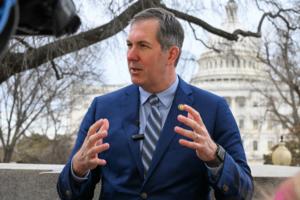Current News
/ArcaMax

Mike Johnson wins gavel after flipping first-ballot holdouts
WASHINGTON — The new Congress got off to a stumbling start Friday, as Mike Johnson initially appeared to fall short of winning the speakership on the first ballot, before some last-minute arm-bending convinced two Republican holdouts to switch their votes. Johnson was elected speaker with 218 votes, the bare minimum.
Starting the year off ...Read more

Mike Johnson wins reelection House Speaker on first ballot with boost from Trump
House Speaker Mike Johnson won reelection on the first ballot Friday after the Republican leader wrangled final support from a few reluctant right-wing hardliners.
Johnson, who enjoyed the support of President-elect Donald Trump, won the vote by 218-215, with only one GOP lawmaker, Rep. Tom Massie of Kentucky, voting against him.
Two other GOP...Read more

Angela Alsobrooks takes historic oath of office as new Maryland lawmakers begin session
WASHINGTON — Angela Alsobrooks — with an oath to her country and a handshake from her mentor and friend, Vice President Kamala Harris — on Friday began her tenure as one of Maryland’s two U.S. senators, becoming the first Black woman and second woman ever to hold the role.
The Democrat from Prince George’s County was the first newly ...Read more

Family, friends of Cybertruck driver express shock, reports say
LAS VEGAS — As authorities search for a motive behind the New Year’s Day truck explosion outside Trump International, friends and family of the suspected driver — a decorated active-duty member of the U.S. Army — talked to the media about his life and what is known of his last days.
At a news conference, Metropolitan Police Department ...Read more

Former Sen. Bob Menendez's lawyers ask judge for leniency in corruption case
WASHINGTON — Attorneys for Bob Menendez painted him as a defeated man as they asked a federal court for leniency when sentencing the former senator, who was found guilty last summer on all charges in a sweeping federal corruption case.
As the 71-year-old longtime New Jersey Democrat is set to be sentenced in New York on Jan. 29, Menendez ...Read more

Delaware makes history as Sarah McBride and Lisa Blunt Rochester take the oath in Washington
WASHINGTON — It's a historic day for Delaware in Washington.
Democrat Lisa Blunt Rochester will be sworn into the Senate Friday, becoming the first Black woman to represent the state in the chamber after four terms in the U.S. House.
Taking her seat in the House will be Sarah McBride, who will officially become the first transgender person ...Read more

Jimmy Carter's tiny hometown braces for influx before funeral procession
PLAINS, Ga. — Residents in Jimmy Carter’s hometown tried their best to go about their business Friday as their farming whistle-stop prepared for a presidential farewell that will last nearly a week.
Before midday, while crews set up barricades and braced for an influx of visitors from all over, television trucks from Atlanta to Jacksonville...Read more

Rudy Giuliani faces contempt hearing for failure to hand over assets to Georgia mother and daughter he defamed
NEW YORK — Rudy Giuliani faces a contempt hearing in Manhattan federal court Friday for failing to satisfy a judge’s orders to cough up assets to the Georgia mother and daughter he was found liable for defaming.
The former New York City mayor turned up for the hearing after his legal team tried to get him out of having to appear in person ...Read more

Mike Johnson wins reelection as House speaker on first ballot with boost from Trump
House Speaker Mike Johnson won reelection on the first ballot Friday after the Republican leader wrangled final support from a few reluctant right-wing hardliners.
Johnson, who enjoyed the support of President-elect Donald Trump, won the vote by 218-215, with only one GOP lawmaker, Rep. Tom Massie of Kentucky, voting against him.
Two other GOP...Read more

Biden blocks Nippon Steel's $14.1 billion takeover of US Steel
President Joe Biden has blocked the $14.1 billion sale of United States Steel Corp. to Nippon Steel Corp., killing a high-profile deal that sparked a political firestorm and tensions between the U.S. and Japan.
Biden announced his formal decision on Friday after the case was referred to him by a U.S. security review panel, ahead of a deadline ...Read more

NY attorney general Letitia James recuses self from probe into beating death of Marcy inmate Robert Brooks
NEW YORK — Attorney General Letitia James’ office is backing away from the criminal probe into the caught-on-camera beating death of Marcy Correctional inmate Robert Brooks, officials said Friday.
In a video update released Thursday, James said her office needs to recuse itself since four of the state Department of Corrections officers ...Read more

Mike Johnson just short of winning reelection as House speaker on first ballot
U.S. House Speaker Mike Johnson fell short of winning reelection on a first ballot Friday, leaving the Republican leader’s future somewhat unclear as he tries to retain his position in the narrowly divided Congress.
Three GOP lawmakers, Rep. Tom Massie of Kentucky, Rep. Ralph Norman of South Carolina and Rep. Keith Self of Texas voted against...Read more

Rachel Morin case: Defense seeks to move trial out of Harford County
BALTIMORE — The defense team representing Victor Martinez-Hernandez motioned for a change of venue out of Harford County Circuit Court in a Monday filing, stating their client “cannot receive a fair trial” there.
Martinez-Hernandez, 24, of El Salvador, is charged with first- and second-degree murder, first- and second-degree rape, third-...Read more

US surgeon general wants to label alcohol like cigarettes
Wine, beer and spirits should carry a warning label about cancer risks, the U.S. surgeon general said Friday, in a move that could shape a larger debate over government healthy eating recommendations.
“Alcohol is a well-established, preventable cause of cancer responsible for about 100,000 cases of cancer and 20,000 cancer deaths annually in ...Read more
Convicted Massachusetts ex-senator who wants Trump pardon says he saw a police shooting, as he pushed for sentencing delay
BOSTON — A former state senator convicted of fraud who wants a pardon from President-elect Donald Trump says he recently witnessed a police-involved shooting, as he pushed for a delay in his sentencing.
Dean Tran, a Massachusetts Republican who ran for Congress, last year was found guilty of pandemic assistance fraud and making false ...Read more

Federal government approves Okefenokee wildlife refuge expansion plan
ATLANTA — The U.S. Fish and Wildlife Service announced Friday it has finalized a plan that could lead to the expansion the Okefenokee National Wildlife Refuge.
The plan approved by the FWS — which manages the 407,000-acre refuge — adds 22,000 acres to the Okefenokee’s “acquisition boundary.” That includes the creation of a 1-mile �...Read more

Amid shocking crimes on NYC subways, Gov. Kathy Hochul pushes for expanding involuntary commitments
NEW YORK — Gov. Kathy Hochul said Friday she’d introduce legislation to the state budget that would make it easier to involuntarily commit those suffering from mental illness to hospitals, citing an uptick in violent crimes on the NYC subway system.
A spate of shocking crimes — including the woman fatally set on fire aboard a Brooklyn F ...Read more

US surgeon general calls for cancer warnings on alcohol
WASHINGTON — Alcohol products like beer and wine should carry warnings of their links to cancer, the US surgeon general said, citing an increased risk of developing tumors in the breast and other parts of the body.
Scientific evidence of the connections between alcohol and cancer has been rising for decades, but less than half of Americans ...Read more

NYC congestion pricing begins Sunday: What you need to know
NEW YORK — Congestion tolling is scheduled to start on January 5 in NYC, barring any last minute legal challenges.
The path to this point has been long and confusing — so drivers have many questions about the MTA’s plan to reduce congestion and raise funds for mass transit improvements.
Here’s what you need to know:
When exactly ...Read more

Jay-Z can file for dismissal of rape lawsuit against him, Diddy, report says
NEW YORK — A New York City judge on Thursday granted Jay-Z’s request to file a motion for dismissal of a lawsuit that accuses the rap titan of raping a 13-year-old with Sean “Diddy” Combs in 2000.
Judge Analisa Torres of the Southern District of New York said Jay-Z’s lawyer, Alex Spiro, can file the motion by Feb. 6, according to ...Read more
Popular Stories
- Uncle says Cybertruck driver was Trump supporter, questions whether explosion was intentional
- Atlanta journalist recounts old Georgia State University interview with New Orleans terrorist attack suspect
- Does drinking milk really make congestion worse?
- The Trump era of Congress begins, with a majority in House arriving since 2016
- 'Oh my God': Plane suddenly slams into Orange County warehouse, killing 2 and injuring 18





